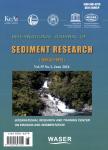Climatic and anthropogenic impacts on the decrease of sediment discharge to the Mediterranean coast from the largest river of Maghreb
Climatic and anthropogenic impacts on the decrease of sediment discharge to the Mediterranean coast from the largest river of Maghreb作者机构:National High School of Hydraulics
出 版 物:《International Journal of Sediment Research》 (国际泥沙研究(英文版))
年 卷 期:2021年第36卷第2期
页 面:268-278页
核心收录:
学科分类:070704[理学-海洋地质] 0709[理学-地质学] 07[理学] 0707[理学-海洋科学] 08[工学] 081502[工学-水力学及河流动力学] 0815[工学-水利工程]
基 金:supported by the Partenariat Hubert Curien (PHC) TASSILI Program [NPHC TASSILI: 18MDU109] the young team of the National High School of Hydraulic of Blida (JEAI JEENS) associated by the Institut de Recherche pour le Developpement (IRD)
主 题:Sediment discharge Cheliff River Algeria North Africa Dams Mediterranean Sea
摘 要:The current study focuses on the issue of the decrease in sediment discharge to the Mediterranean Sea by the largest river in Algeria, the Wadi Cheliff(i.e. Cheliff River). This study clarifies the effect of climatic and anthropogenic factors on the changes in the sedimentary dynamics of the Cheliff River discharging to the sea. The data used(rainfall, water discharge, and sediment discharge) concern the Sidi Bel Attar gaging station on the Cheliff River, only 18 km from discharge to the Mediterranean Sea. A power-type statistical regression model was used to fill the 74.2% gap in Suspended Solids(SS) measurements in the establishment of a SS database for the period 1951 e2012. The study results show that the transport of suspended sediment discharged to the sea is about 487 t/km2/yr. Statistical tests of breaks highlight that rainfall decreased by 26% and that water and sediment input to the sea declined from 74% to 63% for the period of 1981 e2012. The correlation analysis shows a decrease in the contribution of rainfall on sediment and water input at the outlet equal to 77.9% and 77.8%, respectively, during the period of 1980 e2012, compared to the period of 1968 e1980. However, the double mass method reflects the contribution of factors other than rainfall to the decrease of sediment input to the sea. These other factors mainly include large dams, which intercepted about 71% of the total volume of sediment discharged to the sea during the period of 1968 e2010. In addition the contribution of large dams to the reduction of sedimentary input to the sea is more important than that of the decrease in rainfall. The management of large dams also contributes to the increase in the sediment deficit to the sea through the prioritization of interception of sediment at the expense of releases, for socio-economic purposes, 68.4% of the Cheliff River discharge is diverted for human use. This has led to an increase in the mean water bed level at bankfull downstream, where the



